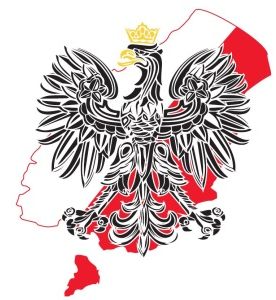Allanton
First Polish Church in the South Island
Church of the Sacred Heart – Six generations of the Polish faithful
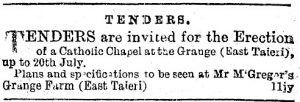
Courtesy of Papers Past | Newspapers | Otago Daily Times | 15 July 1870 | Page 1 Advertisements Column 7 (natlib.govt.nz)
When the first Bishop, Dr. Moran arrived in Dunedin in 1871, to establish a diocese in Otago, he arrived in time to open the first Catholic church on the Taieri Plain.
“A new Roman Catholic Chapel is in course of erection at East Taieri and the dimensions to be 40 x 20 feet. The contractor is a West Taieri man.” Bruce Herald, 31 August 1870
This was the only Catholic church between Dunedin and Milton and the site chosen was near the Grange, predicting a flourishing settlement at Riccarton as various stores and services were beginning to appear there.
“The Right Rev. Dr Moran, Bishop of Dunedin, will on next Sunday consecrate the newly erected Catholic church in East Taieri (or Grange) at 11 o’clock on Mr Macgregor’s Farm, East Taieri. A four-horse coach will leave the Gridiron Hotel, tomorrow morning at 9 o’clock sharp, for the purpose of conveying parties desirous of witnessing the above interesting ceremony, returning immediately after. Fares moderate. J. Steadman.” Otago Daily Times, 25 Feb 1871
The Chapel was opened on the 26th of February 1871 and was consecrated ‘Church of the Immaculate Conception‘.
“Consecration of Catholic Chapel, at The Taieri. —The Right Reverend Dr Moran, Bishop of Dunedin, yesterday consecrated the Catholic Church at East Taieri, in the presence of the congregation and a large number of visitors from Dunedin, and the country districts. Mass was celebrated by the Rev. Father Maloney, P.P. His Lordship preached a powerful and eloquent sermon on the duties and obligations of religion, premising his remarks with a reference to the day’s proceedings. He congratulated the congregation upon the fact that the church was completely out of debt—a circumstance as gratifying to the initiators of the work as to himself. To inaugurate a work like the one he had inaugurated that day so soon after his arrival in the Colony, was a circumstance peculiarly gratifying to him, because it spoke of the progress of religion and of sincerity, faith, and piety of the people. It gave him consolation, therefore, because it gave him hope for the future. But that was not the only circumstance which rendered it peculiar to himself; there was connected with the consecration a circumstance which brought his memory back many years. He had that day dedicated the little church in which he was speaking to the Immaculate Mary, and that reminded him that the first church in his former diocese was similarly dedicated. He expressed a wish that the congregation might long be able to meet and work together in the good cause. A portion of St. Joseph’s choir, strengthened by Mr Leslie, who sang the solos, rendered Natividad’s mass very nicely, Mrs Conway presiding at the harmonium. The day’s collection amounted to close upon L2O. The church, which is capable of holding nearly 200 people, was built at a cost of L 350, and was finished early in January. It is situated on a portion of the Grange property, the land on which it is built being the gift of Mr N. B. Macgregor, who was also a subscriber to the extent of nearly one-third its cost, and to whose efforts, we believe its erection is mainly due.” The Evening Star, 27 February 1871
The chapel was to service the whole of the Taieri but infrequent as the religious ceremonies were infrequent due to the shortage of priests, thus the building stood as a silent reminder of God’s presence. Records show that Bishop Moran officiated at the chapel, the weddings of Jozef Pedowski to Maryanna Walinska on 29 January 1875 and Jan Switalla to Marta Piernicka on 10 November 1881.
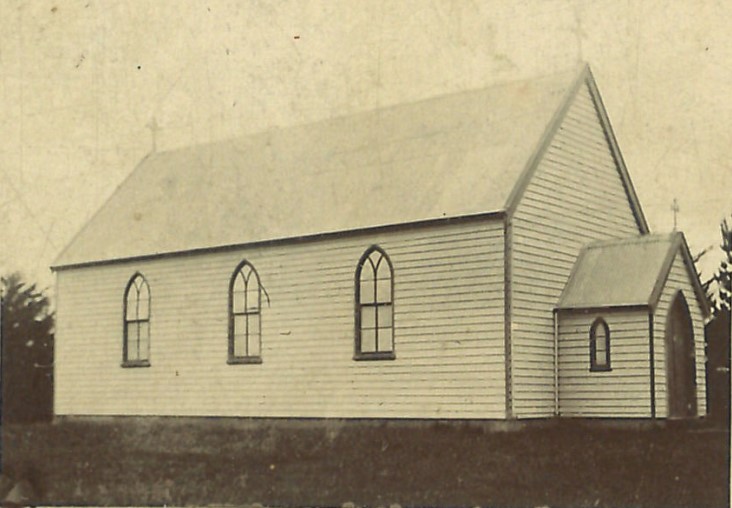
Church of the Sacred Heart in 1905, courtesy of the New Zealand Tablet
Early Polish marriages held at the Chapel at East Taieri
1875, 29 Jan Joseph Pedouski – Maria Walinski
1876, 8 Jul, John Black – Rosa Klass
1879, 28 Dec, Carl Jung – Anne Schreiffer nee Walinska
1881, 27 Mar, Martin Grantz – Mary Somers nee Frawley
1881, 10 Nov, John Switalla – Martha Pernitskie
Not long after the opening of the chapel at Riccarton, a woollen factory, for the manufacture of blankets, tweeds, and other fabrics was established on what was ‘Mosgiel farm’, It then appeared people preferred to settle around the mill rejecting the small settlement at Riccarton now East Taieri, which was to include Mosgiel Junction. Bishop Moran could see the small chapel was going to be inadequate for the growing population at Mosgiel and so opened ‘St. Mary’s‘ in Gordon Road, Mosgiel on the 19th of June 1887. The Poles at Allanton were in desperate need of a church of their own and it made sense to relocate the church at Riccarton. In his address to the congregation, he said;
“This Church no longer suffices to your needs, and on this account we are all here assembled to lay the foundation stone of a new Church in Mosgiel, a place with more population than East Taieri and more convenient for the congregation. The old church and its associations will not, however be lost to memory, as it is to be taken down and re-erected at Greytown for the accommodation of the Polish Catholics of that place, a people not inferior to yourself in depth and sincerity of faith, in practice of their religion and their Christian generosity. To you and to them great credit is due, and great thanks are owing for the determination and luck and generosity with which you have all entered on this twofold undertaking. That you will carry it to a successful conclusion no doubt whatever can be entertained”
The Allanton community held a concert at the Athenaeum Hall to raise the funds for its relocation. The site for the church was purchased from John Mitchell, a setter. It is believed Father James O’Neill supervised the dismantlement and re-erection of the church on the 24th of June 1887.
The church was blessed and opened on 19 October 1888 by Bishop Moran and was consecrated ‘Church of the Sacred Heart‘. During his blessing he addressed the following.
“It is now only a few months more than 16 years since we first met not far from where we stand, and on an interesting occasion, an occasion to be remembered by me as well as by you. On that occasion it was my pleasing duty to open the new Church of the Immaculate Conception you had lately erected at East Taieri, the first Church blessed and opened by me in this Diocese.”
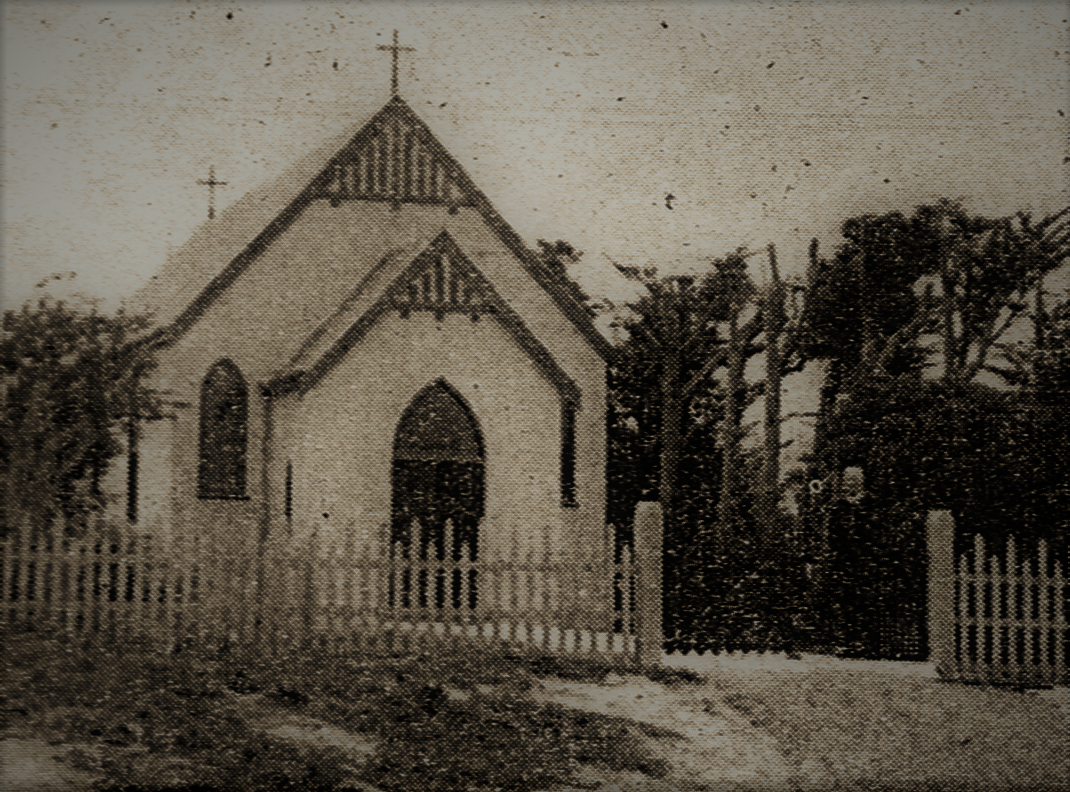
Sacred Heart after restoration (roughcasting). 1948 Ca, courtesy of New Zealand Tablet
“GREYTOWN ROMAN CATHOLIC CHURCH.
The church recently erected at Greytown was opened last Sunday forenoon by the Most Rev. Dr Moran. High mass was celebrated by the Bishop, Father O’Neil being deacon; and Father Lynch, sub deacon. There was a large attendance, the building being found insufficient to accommodate all who had put in an appearance. The greater part of the congregation is composed of Polish Catholics, and during the sermon the Bishop appropriately referred to the struggles which Poland had been made in the past in the cause of their religion. In his introductory remarks, His Lordship said that he had come to dedicate the church, with all the ceremony they could command under the circumstances. It has been dedicated to Almighty God as the Church of the Sacred Heart of Jesus. He congratulated them on the erection of the building, which was alike creditable to them and to their pastor. It supplied a long-felt want, and he trusted it would be the means of great spiritual advancement. The majority of people who would worship in this church belonged to the Polish nation, who held a conspicuous place in history as a nation, which existed no longer – that was, it was no longer known in its political capacity. They were a great Catholic people: full of faith; full of piety; practicing their holy religion, and making for it the very greatest sacrifices that people could make. He then dwelt upon the way in which the Polish people, throughout all their persecution had adhered to the Roman Catholic faith; and said that he had no doubt that a great and good day was in store for Poland; he hoped that it would be so and that it would become once more a great Roman Catholic nation. Europe was indebted to the Polish nation for stemming the Mohammedan invasion which had threatened to over-run it. Something was in store for a people who had been so faithful and so brave and who had made so many sacrifices for God and their church. He trusted that they, representatives of that illustrious nation, would never prove themselves to be unworthy of the history of the race to which they belonged. He trusted that the Poles here would give good examples to their fellow Catholics. He hoped that the children would be gathered together in the church every Sunday, and that some of the devoted men of the congregation would come and teach them the catechism – the great truths of their holy religion. He prayed that Almighty God would bless this church and bless the congregation which would worship it. The musical portion of the ceremony was provided by the Mosgiel Roman Catholic Choir, Madam Ivens presiding at the harmonium. Visitors were present from Tokomairiro, Kuri Bush, Mosgiel and other districts. The collection amounted to the handsome sum of £75.” The Taieri Advocate, 17 October 1888.
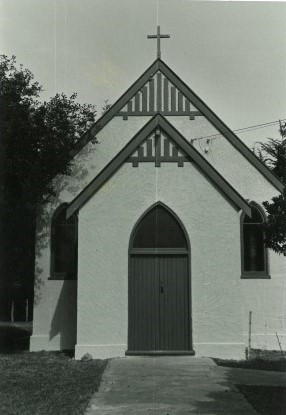
Church of the Sacred Heart, courtesy of St. Joseh’s Archives, Dunedin
The church had seen many baptisms, weddings and funerals over the years but there is one that comes to mention in the way of a double wedding of John Smolenski to Annie Black and Antoni Velenski to Martha Smolenski on 19 July 1899. In this incidence both grooms unfortunately had succumbed to an early death with John passing away aged 31 in 1905 and Antoni aged 44 in 1915. Superstitiously it led to some of the family members believing that double weddings had become a bad omen. Throughout Allanton, in the unsettled blocks of land, one could see man made tracks carved out in the long grass where the local Poles had skipped the corners for a short cut to church. While the setters were aging and the next generation moved further afield, the congregation slowly dwindled and there was subsequent deterioration of the church building.
In 1948, Father M. W. Woods was successful in having the building completely renovated, and the church returned to full use. In February 1971, special celebrations to mark the Centenary of the Church took place, followed by an afternoon tea at the home of Gaye and Harry Cuttance on Main South Road. Mass at this time was held every second Sunday, alternating with the church at Outram, which was also in the Mosgiel Parish. The church had its final mass celebrated there in September of 2005 and was soon deconsecrated thereafter. The church was sold and unfortunately demolished not before some interest was shown to rescue its plight. It was the oldest Catholic Church between Dunedin and Milton and the first Polish Church in the South Island.
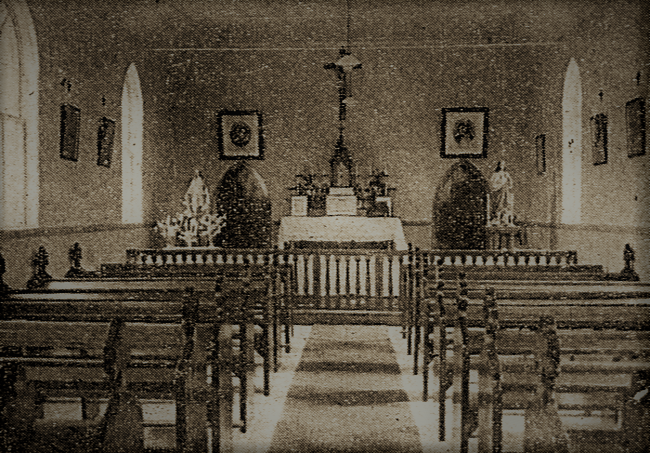
Altar at Sacred Heart in 1948, courtesy of New Zealand Tablet
Polish marriages held at the church of the Sacred Heart at Allanton
1889, 1 May, Joseph Belsky – Rose Kovalevski
1889, 1 May, Frank Kovalevski – Annie Belisky
1893, 22 Nov, Charles Newman – Rose Gorinski
1899, 19 Jul, John Smolenski – Annie Black
1899, 19 Jul, Antoni Velenski – Martha Smolenski
1899, 27 Sep, James Millar – Mary Wroblenski
1899, 4 Oct, James Alexander McCutcheon – Martha Pedofsky
1902, 31 Dec, August Joseph Orlowski – Julia Dysarski
1903, 18 Nov, John Philipowski – Annie Gorinski
1904, 6 Apr, Joseph Schriffer – Maggie Kiely
1904, 23 Nov, Frank Wrobefski – Catherine Dwyer
1905, 24 Apr, Thomas Joseph Boyle – Wilhelmina Kreft
1905, 9 Aug, Michael Nolan – Jeanie Agnes Black
1908, 24 Jun, Frank Schimanski – Mary Black
1911, 25 Oct, Joseph Buchols – Nellie Wooliams
1913, 24 Mar, Edward Herbert Keen – Rosie Smolenski
1915, 27 Dec, John Michael Ryan – Matilda Pedofsky
1917, 17 Jan, Herbert George Christie – Barbara Beleski
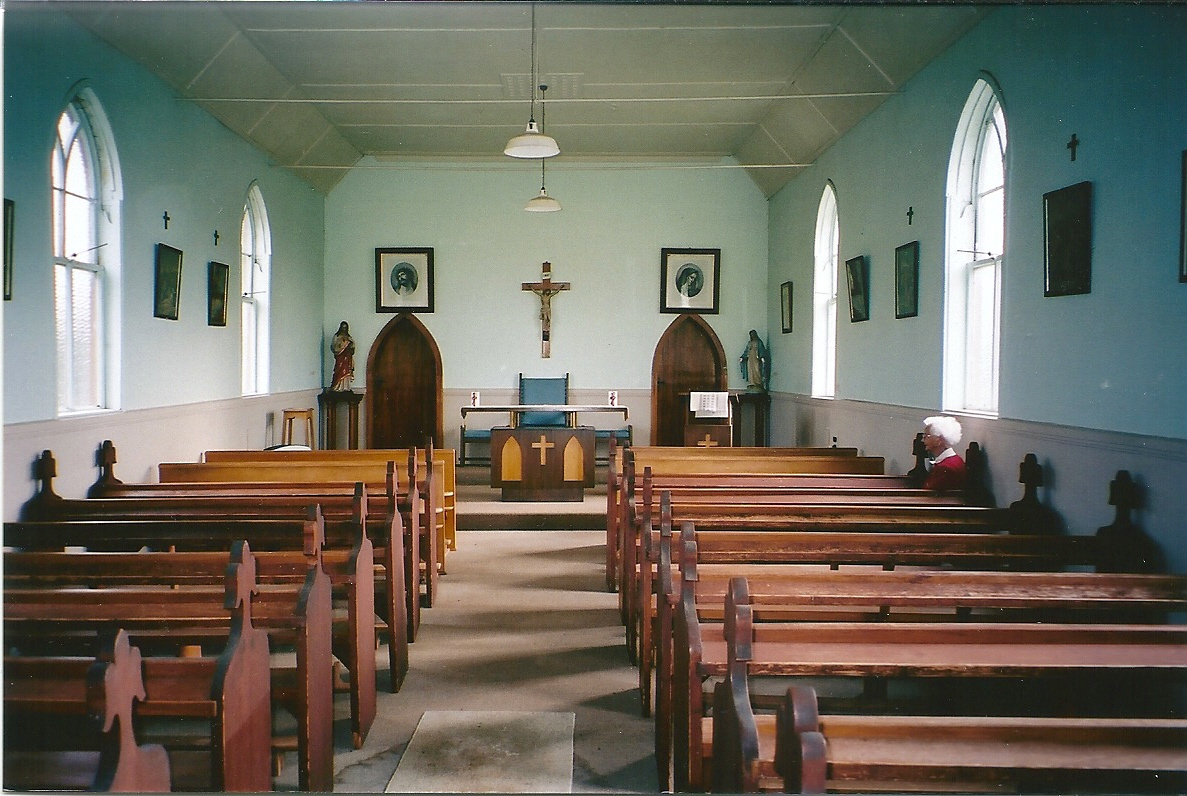
Mona Todd – A last reflection, courtesy of Paul Klemick
Funerals held at the Sacred Heart.
“FUNERAL NOTICE. The Funeral of the late JOSEPH GORINSKI will leave the Roman Catholic Church, Allanton, at 2.30 p.m., THIS DAY (FRIDAY), July 9, for the Allanton Cemetery. Friends will kindly accept this intimation. BREMNER. & FOWLER, Undertakers, Mosgiel.” Otago Daily Times, 9 July 1909, p 4
“FUNERAL NOTICE. The Friends of Mr JOHN SMOLENSKI (and Family) are respectfully invited to attend the Funeral of his late WIFE, FRANCES, which will leave the Roman Catholic Church, Allanton, for the Allanton Cemetery, THIS DAY (THURSDAY), the 20th inst., at 2 o’clock. A. J. WYNN & HOPE, Undertakers, 36 St. Andrew street.” Otago Daily Times, 20 March 1913, p 6
“FUNERAL NOTICE. The Friends of the late ANTON LUDWIG PERNESKIE (and Family) are respectfully invited to attend his Funeral, which will leave the Church of Sacred Heart, Allanton, TO-MORROW (THURSDAY), the 5th inst., at 11.30 a.m., for the Southern Catholic Cemetery, passing through Caversham at 2.15 p.m.—HUGH GOURLEY, Undertaker, Clarke and Maclaggan streets.” Otago Daily Times, 4 February 1914, p 4
“FUNERAL NOTICE. The Friends of the late ANTONY VALENSKI (and Family) are respectfully invited to attend his Funeral, which will leave the Catholic Church, Allanton, TOMORROW (SATURDAY), , the 20th inst., at 2 o clock, for the Allanton Cemetery A. J. WYNN & HOPE, Undertakers, 36 St. Andrew street.” Otago Daily Times, 19 March 1915, p 4
“DEATHS. DYSASKI—On July 14, 1920, art Dunedin, John, dearly beloved husband of Julia Dysaski, Allanton; aged 84 years. R.I.P.— The Funeral will leave the Roman Catholic Church, Allanton, on Saturday, 17th inst., at 10.30 a.m., for the Allanton Cemetery.— Hugh Gourley, undertaker.” Otago Daily Times, 15 July 1920, p 4
“DEATHS. SMOLENSKI.—On October 3, at the residence of his daughter (Mrs Palmer), 524 Cumberland street, John Smolenski; aged 82 years. R.I.P. —The Funeral will leave the Allanton Catholic Church on Thursday, November 5, at 2.30 p.m., for the Allanton Cemetery.—Hope and Kinaston, undertakers.” Otago Daily Times, 4 October 1922, p 6
“FUNERAL NOTICE. The Friends of the late ANNIE GORINSKI (and Family) are respectfully invited to attend her Funeral, which will leave the Roman Catholic Church, Allanton, THIS DAY (MONDAY), October 1. at 2.30 p.m., for Allanton Cemetery. R. MUIRHEAD, Undertaker.” Otago Daily Times, 1 October 1923, p 6
“DEATHS. The Friends of the late CATHERINE WROBLENSKI (and Family) are respectfully invited to attend her Funeral, which will leave the Roman Catholic Church, Allanton, at 11 a.m. on SATURDAY, the 13th. R. CAMPBELL & SON, Undertakers.” Otago Daily Times, 11 December 1924, p 8
“DEATHS. PEDOFSKY. —On August 4, 1926, at his residence, Allanton, Joseph, dearly beloved husband of Mary Pedofsky; in his elghtyflrst year. R.I.P. Requiem Mass at Allanton Church on Saturday, 7th inst., 9.30 a.m.” Otago Daily Times, 6 August 1926, p 8
“DEATHS. DYSARSKI.—On February 18, 1928, at Allanton, Julia, dearly beloved wife of the late John Dysarski; aged 90 years. R.I.P. The Funeral will leave the Catholic Church, Allanton, To-morrow (Tuesday), at 11 a.m., for the Allanton Cemetery. Friends please accept this, the only, intimation.—-Robert John Campbell, undertaker, Mosglel.” Otago Daily Times, 20 February 1928, p 8
“DEATHS. JUNGE.—On October 20, 1932, at Dunedin, Anna, beloved wife of the late Carl Nicholas Junge, late of Allanton: aged 76 years. R.I.P. Requiem Mass at the Catholic Church, Allanton, To-morrow (Saturday), October 22, at 10 a.m.—The Funeral will leave the church at 11 a.m. tor the Allanton Cemetery.—W. H. Cole, undertaker.” Otago Daily Times, 21 October 1932, p 8
“DEATHS. PEDOFSKI.-On February 7th, 1934, at her residence, Allanton, Mary, beloved wife of the late Joseph Pedofski; in her 75th year. R.I.P. Requiem Mass at 10 a.m., Friday.—Friends are invited to attend the Funeral, which will leave the Allanton Catholic Church on Friday, at 2.30 p.m., for the Allanton Cemetery.—R. J. Campbell, undertaker.” Evening Star, 7 February 1934, p 6
“DEATHS. BELESKI.—On December 6. 1940, at his residence, Allanton, Joseph, dearly beloved husband of Rose Beleski; in his seventyeighth year. R.l.P.—The Funeral will leave the Allanton Catholic Church on Sunday, 8th inst., at 2.30 p.m., for the Allanton Cemetery.—R. Campbell and Son, funeral directors.” Evening Star, 6 December 1940, p 4
“DEATHS. BELESKI.—On May 1, 1941, at her residence, Allanton, Rose, beloved wife of the late Joseph Beleski; in her seventy-ninth year. R.I.P. Requiem Mass on Saturday, 3rd, at 9.30 a.m., at Allanton Catholic Church.—The Funeral will leave the church at, 2 p.m., for the Allanton Cemetery.—R. Campbell and Son, funeral directors.” Otago Daily Times, 2 May 1941, p 1

A time to reflect – Monica Holmes and Mona Todd outside the historical church at Allanton, after attending the thanksgiving mass for its closure, courtesy of Otago Daily Times, 12 September 2005.
‘Sad moment’ Church marks final day by David Loughrey. Mona Todd brought a penny to put in the plate on Saturday, but there was to be no collection at Allanton’s Sacred Heart Catholic Church. The Mass of thanksgiving at the tiny Allanton church marked its final day as a place of worship, after serving the needs of its mainly Polish community since 1888. “People all came in their horse and carts,” 92-year-old Mrs Todd, nee Velenski, said of her memories of the church she had attended since she was 4. Some people walked “for miles” to come to church and others came from as far as Outram and Henley. Saturday’s service was a “sad moment”, Fr Mark Chamberlain said. During the service, he told the congregation it had been a “painful and difficult decision” to let go. It had been sold to a Catholic family who planned to convert it into their family home. “We pray the family home continues to be a place of blessing,” he said. After the service, he said there had been no Mass a the church for the past eight years because of the low number of church-goers and a lack of priests. Church members were now worshipping in Mosgiel. “There are strong connections for Allanton and East Taieri people, and also the Polish people who settled here.” The Polish background was evident on Saturday, as about 40 people attended Mass. Names like Pedofski and Orlowski featured in the programme for the service. Karen Anderton, nee Gorinski, said five generations of her family had gone to the church. Her parents had married there, and her father’s funeral had been the last in the building. “I’m very, very sad at the closure.” Poles had come to the town to build the railway line, she said. The church began as the First Roman Catholic Church in 1871 at East Taieri, but was moved to Allanton, at that time called Greytown, in 1877. The first Mass at the new site was in 1888. Glenys Ferguson said she was baptised and married at Sacred Heart. her mother, who had been in charge of cleaning the church, had her funeral there. Fr Chamberlain said the pews would not be sold, but offered to families. The “statue of our lady” would be offered to the Polish community, and the stations of the cross, altar and lectern would remain within the parish.” Otago Daily Times, 12 September 2005
Unfortunately the family who purchased the church was unable to obtain a building permit and as a result the church was simply demolished.
Resources
Catholic Baptism and Marriage Records, St. Joseph’s, Catholic Archives, Dunedin. Kindly compiled by Pauline Lee
Papers Past | Magazines and Journals | Explore | New Zealand Tablet (natlib.govt.nz)
Pobόg-Jaworowski J. W., History of the Polish Settlers in New Zealand, Warsaw, 1990, p. 24, 25 – 26
Compiled by Paul Klemick (2022)
Chairperson ..... Ewa Rożecka Pollard
Phone ......+64 3 477 5552
Secretary ..... Anna McCreath Munro
Phone ..... +64 3 464 0053
Facebook ..... Poles Down South
Contact Poles Down South
Poles in New Zealand We would like to hear from Poles or people with any Polish connection, who visited New Zealand and particularly those of you who paid a visit or lived anywhere in Otago or Southland.
....................
Polski “Poles Down South” jest stroną internetową organizacji polonijnej w Nowej Zelandii działającej w rejonie Otago i Southland na Wyspie Południowej. Siedzibą organizacji jest Dunedin.
